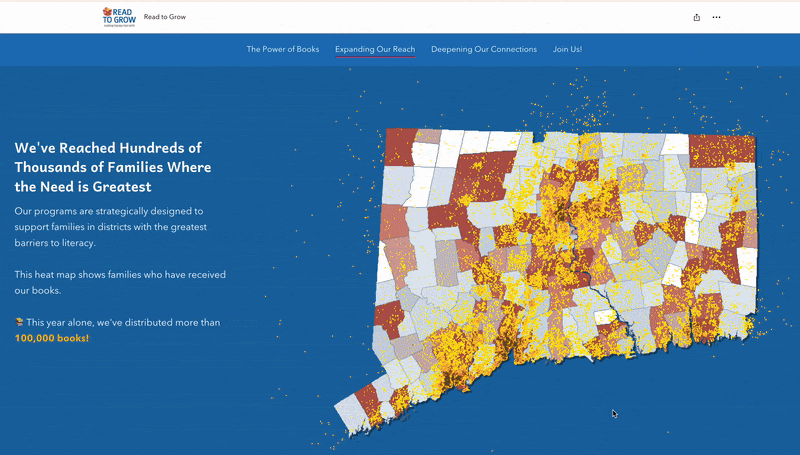Making Space for Story Arcs, Rescued Maps, and Literacy Gaps
- Charles Grosperrin

- Apr 30
- 4 min read
Welcome to this first installment of Making Space - a monthly memo for activists and changemakers about the ideas, tools, and stories that keep us moving, and how they might help you too.
In this issue, you’ll learn:
A 5-part structure for telling an impact story that actually lands
How activists are saving public data tools that shouldn’t have disappeared
How Read to Grow is using maps to close literacy gaps in Connecticut
North Arrow News: We’re an official ESRI Nonprofit Specialty Partner!
Let’s get into it.
Olivia & Charles from North Arrow
Your work is powerful.
How you tell the story shapes how it’s understood.
We’ve worked with mission-driven teams across education, housing, advocacy, and community health. And whether the goal is a report, a campaign, or a grant pitch, the challenge is the same:
How do you communicate impact clearly, emotionally, and visually?
This is the story structure we’ve seen work best, paired with examples from real nonprofits who are using it right now.
The 5-Part Impact Storytelling Blueprint
And now our partners have used it
1. Explain the challenge
What’s broken? Who’s affected? Where is this happening?
Try this: Start with numbers, then show them visually. Maps and data tools can help make complex patterns obvious fast.
It’s a simple but powerful way to make a systemic issue visible at a glance. Instead of burying the problem in a paragraph, the map shows where help is most needed, instantly.

2. Show the solution
What are you doing about it, and why does it work?
This is where you walk the reader through your model, your methods, and your “how.”
Try this:
Don’t just say “we support families.” Show how. Be specific, simple, and visual.

3. Introduce the People
Who is this story really about?
This is where trust happens. It’s where your audience stops thinking about programs and starts thinking about people.
Try this:
Pick one story. One family. One person. Give them a voice. It doesn’t take away from your bigger message, it grounds it.

4. Visualize the Progress
What has changed because of your work?
This is your impact, but visual and narrative, not just numerical.
Try this:
Use a map or timeline to show scale over time or space. Let people scroll through your impact, not just read about it.

5. Paint the Future
What could happen next, with continued support or deeper investment?
Too many stories stop at “Here’s what we did.” Great ones end with “Here’s what we could do.”
Try this:
Even a single sentence that hints at future possibility reframes the story from past-focused to forward-looking.

Use This Framework Anywhere
Whether you're building an annual report, a campaign landing page, or a grant proposal, this 5-part story arc works.
It helps people understand the scale and the soul of your work.
🔦 Activist Spotlight: Maps They Refused to Let Disappear
Some maps are too valuable and too critical to be eradicated by the stroke of a pen on a malicious executive order.
Here are three environmental justice tools that were originally created by U.S. government agencies and recently taken down or jeopardized, only to be preserved or rebuilt by activists and civic technologists:
The Environmental Protection Agency’s EJScreen, saved by Public Environmental Data Partners
A tool for mapping environmental hazards (air pollution, lead paint risk, etc.) alongside vulnerable populations. Taken offline, revived and expanded by climate justice groups.
The Federal Emergency Management Agency’s Future Risk Index, saved by Fulton Ring, Inc:
A map of future climate-linked hazards like wildfire, coastal flooding, and extreme heat. Now maintained and updated by Fulton Ring, Inc. after removal during the Trump era.
The Justice40 Screening Tool, saved by the Environmental Data and Governance Initiative: Created by the Biden administration to direct funds to disadvantaged communities. Activists stepped in to ensure transparency and accessibility when its status became uncertain.
Open data and impact mapping aren't guaranteed, and are not to be taken for granted. They're kept alive by people who believe in public access to truth. Heroes without capes.
Partner Feature: Read to Grow

📖 Based in Connecticut, Read to Grow is on a mission to build literacy from birth. We partnered with them to create a visual impact story that shows where literacy gaps exist and how their programs are closing them.
North Arrow News

We are very proud to have been recognized by ESRI 🌍 as one of their carefully selected Nonprofit Specialty Partners. ESRI is the company behind the great mapping tools we use the most often for our mapping projects. This is an important milestone for us as it stands as a great validation of our mission and expertise. After only two years, we’re listed amongst inspiring businesses that have led in our field for decades. We stand honored, and this gives us a lot of confidence to keep working hard.
💬 Heard something that sparked an idea?
Seen a map or story you love? Have a project where this framework might help?
We’d love to hear from you.
Until next time,
The North Arrow team




Comments